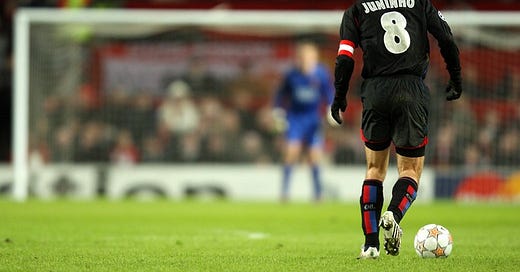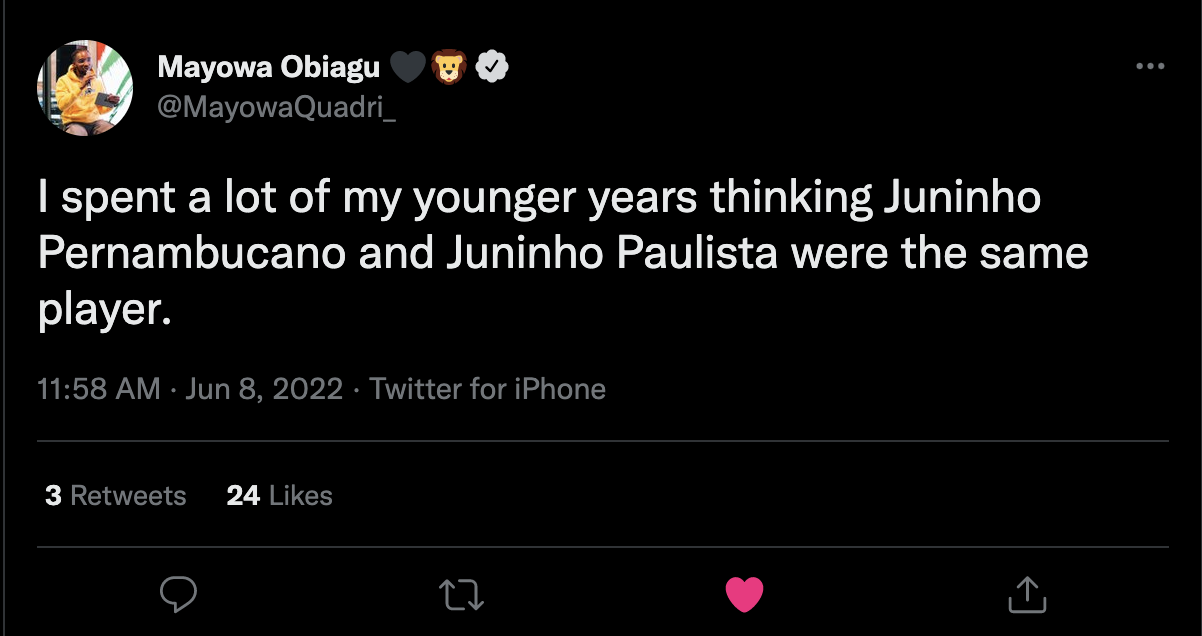(This article was originally posted to Medium on 13th June 2022)
Throughout the years it has been known by many names.
The Brazilians called it ‘La Folha Seca’ (translated as ‘The Dead/Dry leaf’) when midfielder Didi introduced the technique in South America; the Italians dubbed it ‘Maledetta’ (or ‘The Accursed’) when Giuseppe Meazza figured out the same thing halfway around the world.
Some have even referred to it as the ‘Tomahawk’ when it was wrongly attributed to Cristiano Ronaldo as his ‘trademark style’.
But many just know it as the ‘Knuckleball’ and it was a free-kick technique that may have had its roots in the early-to-mid 1900s, but it was perfected and mastered by Juninho Pernambucano.
(Not Juninho Paulista who played for Middlesbrough, just for Mayowa Quadri’s benefit)
The knuckleball was not the only free-kick technique that Juninho was able to employ, but it was the most deadly weapon in his arsenal. In general, the power that the Brazilian was able to generate while putting dip on the ball was second to none; he is the GOAT in this regard, but of course, many over the years have tried to make a stake to his crown.
The aforementioned Ronaldo was famed for his free-kicks in his earlier years, however now, not so much.
I have already mentioned this but while researching for this piece, it came up again, so just to clarify the knuckleball is not ‘Ronaldo’s free kick’. He didn’t invent nor did he even popularise it, so can we just leave that narrative alongside the one that says he still should be the number one free-kick taker at any club.
He has scored 56 free kicks in his entire career, but this season despite numerous attempts, the Portuguese forward only scored one goal for Manchester United from this situation.
This was also the case at Juventus. Over three years, Ronaldo only scored one free-kick, in a 4–1 win against Torino, which came after 43 attempts. It was particularly frustrating to watch as Miralem Pjanic and Paulo Dybala, both much better free-kick takers, were sidelined.
Lionel Messi's name has come up, as you expect it would. The Argentinian has his own technique known as the ‘Sprained Ankle’ which is what allows him to curl the ball around the wall and into the corner of the net.
David Beckham, Roberto Carlos, Ronaldinho and Andrea Pirlo are all excellent free-kick takers, but none compare when placed next to Juninho1.
Pirlo speaks highly of Juninho in his autobiography, I Think Before I Play. He talks about how his search for the perfect technique led him to intently study the Brazilian:
“During his time at Lyon, that man made the ball do some quite extraordinary things. He’d lay it on the ground, twist his body into a few strange shapes, take his run-up and score. He never got it wrong. Never. I checked out his stats and realised it couldn’t just be chance. He was like an orchestra conductor who’d been assembled upside down, with the baton held by his feet instead of his hands.”
Just a side note, I love when players are so good at football that other professionals speak about them in a way that seems like they’re having an existential crisis.
The former Olympique Lyon and Vasco de Gama attacking midfielder scored 74 free-kick goals across his career, and the 44 he scored for the French club can be seen below.
When most players step up to a dead-ball situation, you believe there is a chance they will score, with Juninho it felt like an inevitability, even though over his last three seasons at Lyon he only had 6% (according to Squawka).
As you can see from the graphic, there wasn’t an angle or distance where Juninho couldn’t score, but it is the ones from distance that truly symbolises how dangerous the Brazilian was.
And this is where the knuckleball comes back into play. The colloquial name comes from a type of baseball pitch where the ball swerves at the last second to trick the batter, and this theory transmits to football as it leaves the goalkeeper unsure of where the ball is going to go.
I could try and explain the technique, but I am first and foremost, awful at football, mainly because in Pirlo’s autobiography he gives a fantastic explanation of how to pull it off (the idea strangely came to him on the toilet):
“In essence, the ball needs to be struck from underneath using your first three toes. You have to keep your foot as straight as possible and then relax it in one fell swoop. That way, the ball doesn’t spin in the air but does drop rapidly towards the goal. That’s when it starts to rotate. And that, in a nutshell, is my maledetta.
“When it comes off exactly as I want, there’s no way of keeping it out. It’s specifically designed to head over the wall before taking a direction that nobody can predict. For me, the best feeling in life is watching the ball fly into the net after it whizzes a couple of centimetres over the heads of the defenders. They can almost reach it, but not quite. They can read the maker’s name, but they can’t stop it going in. Sometimes a pinch of sadism is the ingredient that makes victory taste that little bit sweeter.”
Now if you’re a fan of the England football team, that description may bring back sore memories of Euro 2012, but this was Juninho’s reckoning. A combination of technique and power that even the most seasoned of goalkeepers could not deal with.
The player was relentless in refining his craft. Bartek Sylwestrzak is an expert in free-kicks2, helping players across the world improve and he commented on Juninho’s pursuit of perfection in an interview with the Training Ground Guru:
“Commitment, repetition and technical feedback are the foundations of good ball striking. The players with quality are the ones who stayed behind at the end of training to practise.”
“With his technical attributes and physical body shape and practise he was able to take it to the next level. I spoke to one of his former teammates at Lyon, Mahamadou Diarra, and he told me it was remarkable to watch Juninho take these free kicks at the end of a session. Often players do not practise their free kicks at all. Excellence is not possible through team practices. It is an individual skill.”
And it resulted in goals like this:
And this:
And even this (not a knuckleball but shows the control he had over the spin he put on a free kick):
So the question is, why don’t more players do this? Well, the simple answer is that it’s really hard to do. To hit free-kicks at this level of consistency in a match environment takes years of practice and a bulletproof technique.
However, if a player was to emerge with even a third of Juninho’s ability, they would be an asset to any team in the world. So on that train of thought, enter James Ward Prowse.
Now before we get ahead of ourselves, Ward Prowse only scored four free-kicks in 2021/22. He was not ‘scoring them for fun’ as Sky Sports would have led you to believe, but what he did show across the season was versatility and a range of different styles while standing over the ball.
His goals against Newcastle and Crystal Palace were both curled into the near corner, leaving the goalkeeper failing but against Wolves from far out, he tried something completely different. He attempted a knuckleball… and there was nothing Jose Sa could do about it.
Ward Prowse has been coy about how much he practices free-kicks in interviews. Sky Sports asked him in May how much his teammates talk to him about his set-piece routines and he replied:
“Quite a bit, quite a bit. I think it’s something that comes with scoring them, really. But I’m a football fan, a football lover so talking about them is not a problem for me. It’s normally once a week [in terms of practice]. I try and maybe do six a week. I think it’s a nice number to finish on. You don’t get many opportunities in a game regardless, so what’s the point practising 20 a week?”
And I think that the last statement is the crux of why Juninho has never been surpassed when every other aspect of the game has improved. The modern game has become so focused on efficiency; what is the best and easiest way to get the ball into the net.
There is a chance that you could go through an entire game without getting a free kick in a goal-scoring position, but that was the great thing with Juninho, every position was a goalscoring position.
Having a guy who's ‘just a set-piece specialist’ (Juninho was a good player in his own right as well) might not seem worth it to many top clubs, but who knows, with the introduction of five substitutes, the next tactical innovation may be to have a guy you can bring off the bench to take a high-pressure free-kick late in the game and even then sub him back off.
Volleyball has a similar idea with a role called pinch servers. In high-pressure situations, they are brought on to serve and try and win the team several points through them before being subbed back off.
I’m just spit-balling here, I am not a manager nor do I have any coaching badges, so I probably don’t have a clue what I’m talking about.
But focusing back up, what has been the point of this piece?
Well, it’s to tell you that when it comes to free kicks, you may think Ronaldo’s were unstoppable and Messi’s are technical marvels, but regardless of that, there never has been and likely never will be a free-kick taker as good as Juninho Pernambucano to grace the game.
Marcos Assuncao has the technique to compete with Juninho and many will say that he was his equal, however, due to an incomplete record of his time in Brazil (the player himself thinks he scored over 100), his stats do not come close to his countrymen.






